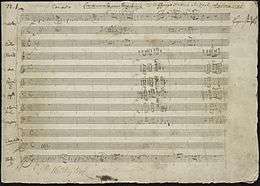Piano Concerto No. 21 (Mozart)
The Piano Concerto No. 21 in C major, K. 467, was completed on 9 March 1785 by Wolfgang Amadeus Mozart, four weeks after the completion of the previous D minor concerto, K. 466.[1][2]
| Piano Concerto in C major | |
|---|---|
| No. 21 | |
| by W. A. Mozart | |
 First page of the autograph manuscript | |
| Key | C major |
| Catalogue | K. 467 |
| Composed | 1785 |
| Movements | Three (Allegro maestoso, Andante, Allegro vivace assai) |
| Scoring |
|
Structure
The concerto is scored for solo piano, flute, two oboes, two bassoons, two horns in C, two trumpets in C, timpani and strings.
The concerto has three movements:
- Allegro maestoso; in common time. The tempo marking is in Mozart's catalog of his own works, but not in the autograph manuscript.[3]
- Andante in F major. In both the autograph score and in his personal catalog, Mozart notated the meter as alla breve.[3]
- Allegro vivace assai
The opening movement begins quietly with a march figure, but quickly moves to a more lyrical melody interspersed with a fanfare in the winds. The music grows abruptly in volume, with the violins taking up the principal melody over the march theme, which is now played by the brass. This uplifting theme transitions to a brief, quieter interlude distinguished by a sighing motif in the brass. The march returns, eventually transitioning to the entrance of the soloist. The soloist plays a brief Eingang (a type of abbreviated cadenza) before resolving to a trill on the dominant G while the strings play the march in C major. The piano then introduces new material in C major and begins transitioning to the dominant key of G major. Immediately after an orchestral cadence finally announces the arrival of the dominant, the music abruptly shifts to G minor in a passage that is reminiscent of the main theme of the Symphony No. 40 in that key.[4] A series of rising and falling chromatic scales then transition the music to the true second theme of the piece, an ebullient G major theme, which can also be heard in Mozart's Third Horn Concerto. The usual development and recapitulation follow. There is a cadenza at the end of the movement, although Mozart's original has been lost.
The famous Andante, in the subdominant key of F major, is in three parts. The opening section is for orchestra only and features muted strings. The first violins play with a dreamlike melody over an accompaniment consisting of second violins and violas playing repeated-note triplets and the cellos and bass playing pizzicato arpeggios. All of the main melodic material of the movement is contained in this orchestral introduction, in either F major or F minor. The second section introduces the solo piano and starts off in F major. It is not a literal repeat, though, as after the first few phrases, new material is interjected which ventures off into different keys. When familiar material returns, the music is now in the dominant keys of C minor and C major. Then it modulates to G minor, then B-flat major, then F minor, which transitions to the third section of the movement. The third section begins with the dreamlike melody again, but this time in the relative key of F major's parallel key, A-flat major. Over the course of this final section, the music makes its way back to the tonic keys of F minor and then F major and a short coda concludes the movement.
The final rondo movement begins with the full orchestra espousing a joyous "jumping" theme. After a short cadenza, the piano joins in and further elaborates. A "call and response" style is apparent, with the piano and ensemble exchanging parts fluidly. The soloist gets scale and arpeggio figurations that enhance the themes, as well as a short cadenza that leads right back to the main theme. The main theme appears one final time, leading to an upward rush of scales that ends on a triumphant note.
Cultural references

The second movement was featured in the 1967 Swedish film Elvira Madigan.[1][5] As a result, the piece has become widely known as the Elvira Madigan concerto.[6][7][8]
Neil Diamond's 1972 song "Song Sung Blue" was based on a theme from the andante movement of the concerto.[9]
References
- Steinberg, Michael (1998). The Concerto: A Listener's Guide. Oxford University Press. pp. 305–307. ISBN 0-19-510330-0.
- Hutchings, A. (1997). A Companion to Mozart's Piano Concertos. Oxford University Press. pp. 135–142. ISBN 0-19-816708-3.
- Neue Mozart-Ausgabe
- Girdlestone, C. M. (1997). Mozart's Piano Concertos. London: Cassell. pp. 332–347. ISBN 0-304-30043-8.
- Small, Allan (1996). Alfred's Basic Piano Library: Classic Themes Level 5. Alfred Publishing. pp. 12, 13. ISBN 0-7390-0356-9.
- Grayson, David A. (1998). Mozart, Piano concertos no. 20 in D minor, K. 466, and no. 21 in C major, K. 467. Cambridge University Press. ISBN 978-0-521-48475-6.
- Mordden, Ethan (1986). A Guide to Orchestral Music: The Handbook for Non-musicians. Oxford University Press. ISBN 978-0-19-504041-8.
- Crutchfield, Will (22 July 1984). "Concert: Alicia de Larrocha and mostly Mozart". The New York Times.
- Iwasaki, Scott (1 August 2008). "Music notes: Diamond DVD is transport to 1976". Deseret News.
External links
- Konzert in C KV 467: Score and critical report (in German) in the Neue Mozart-Ausgabe
- Piano Concerto No. 21: Scores at the International Music Score Library Project (IMSLP)